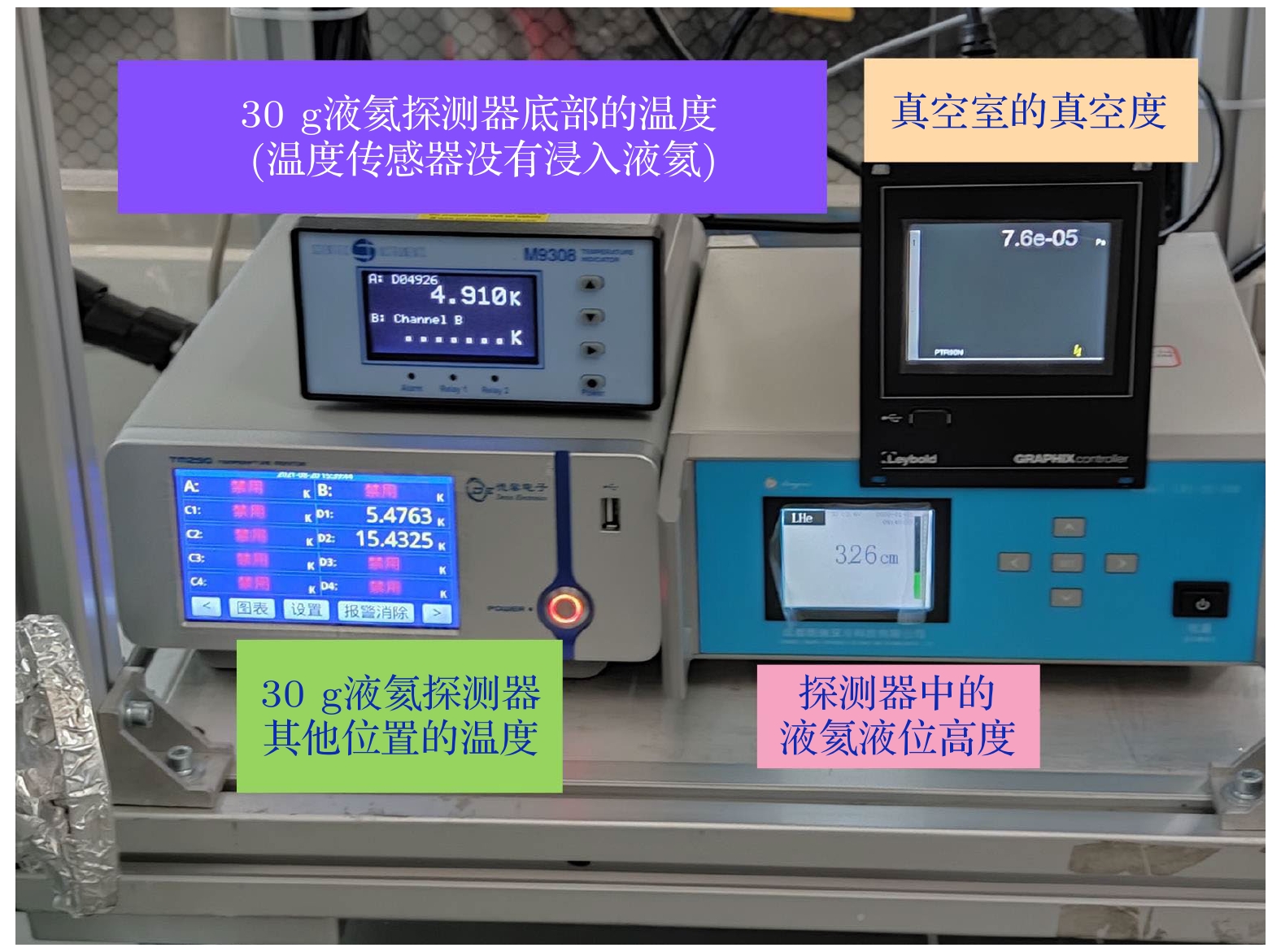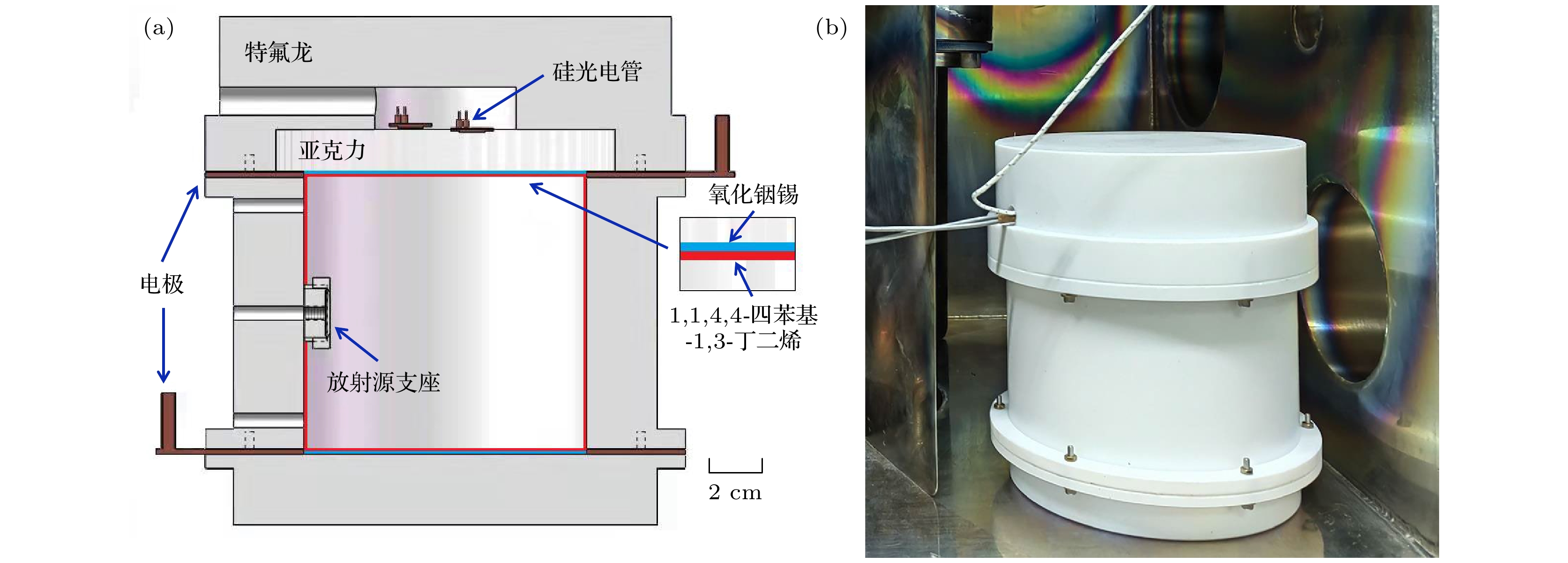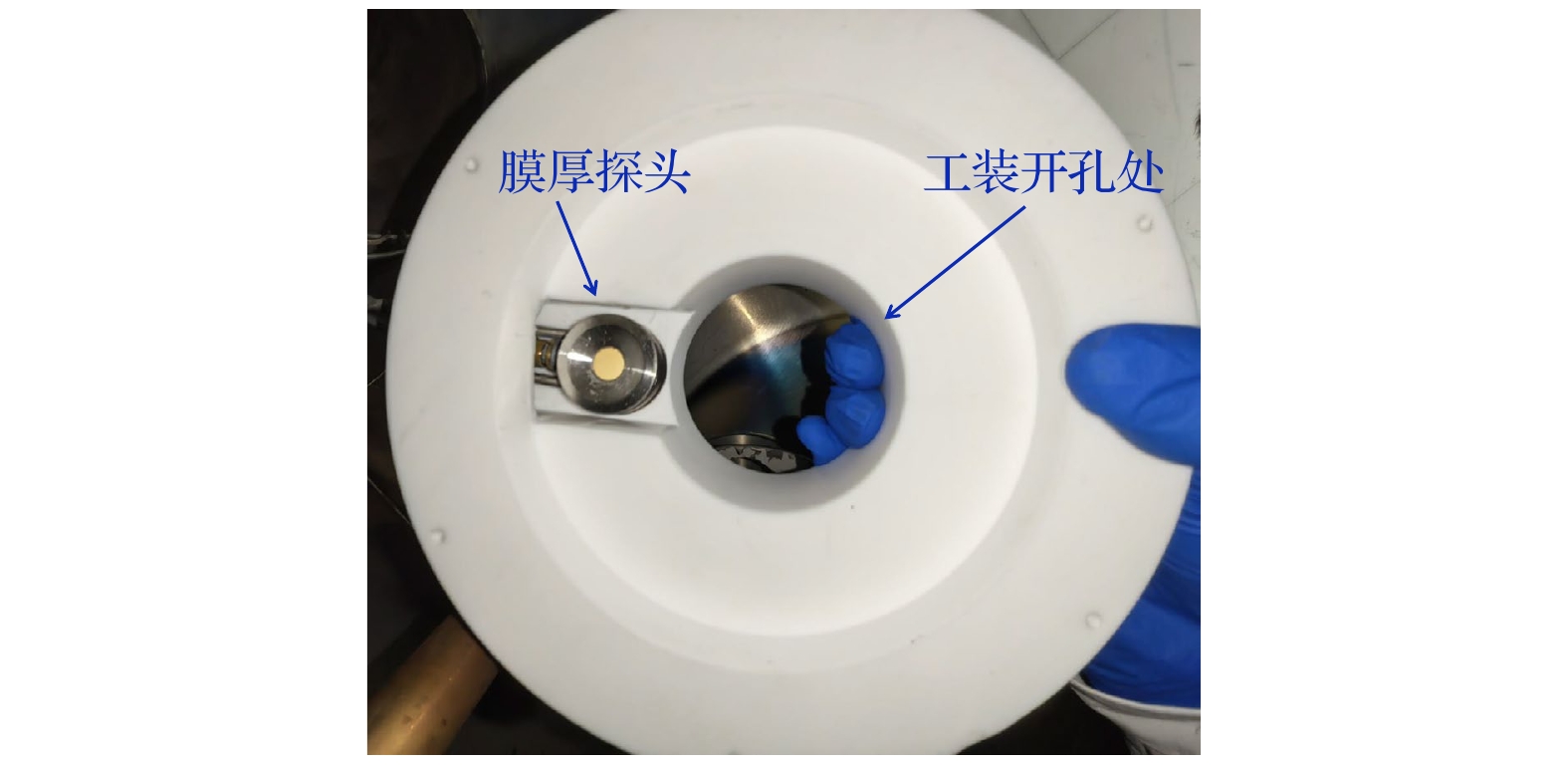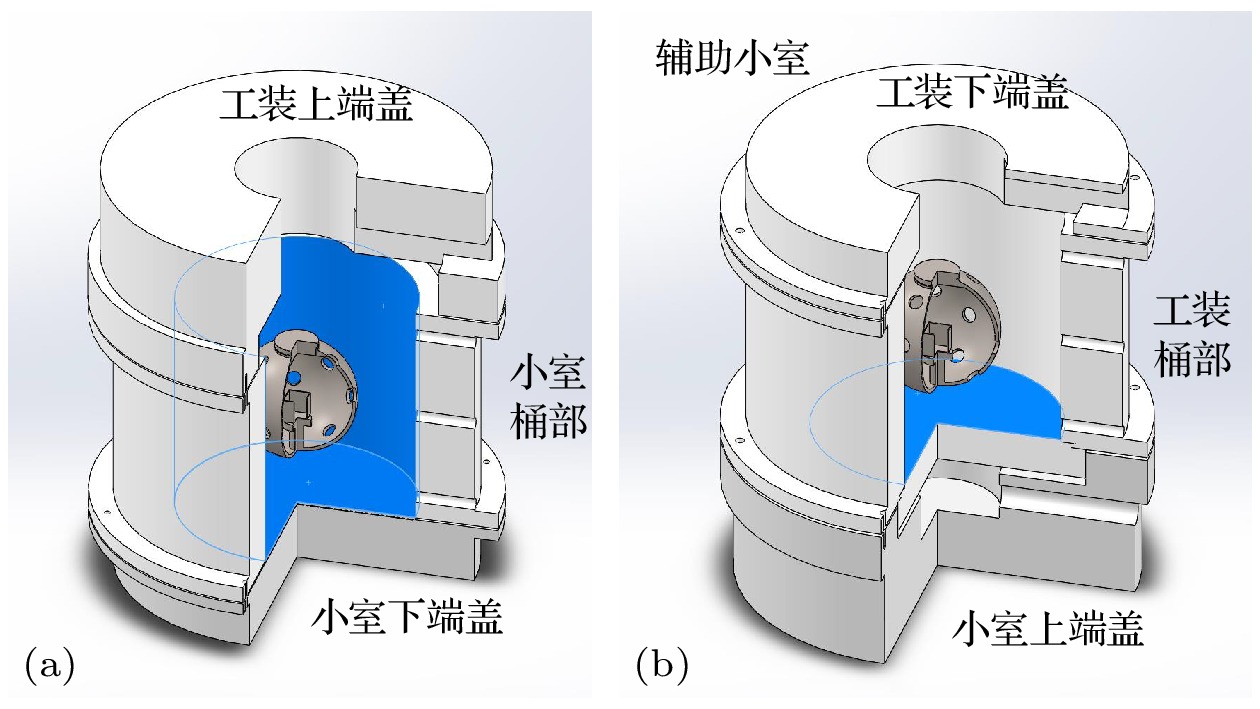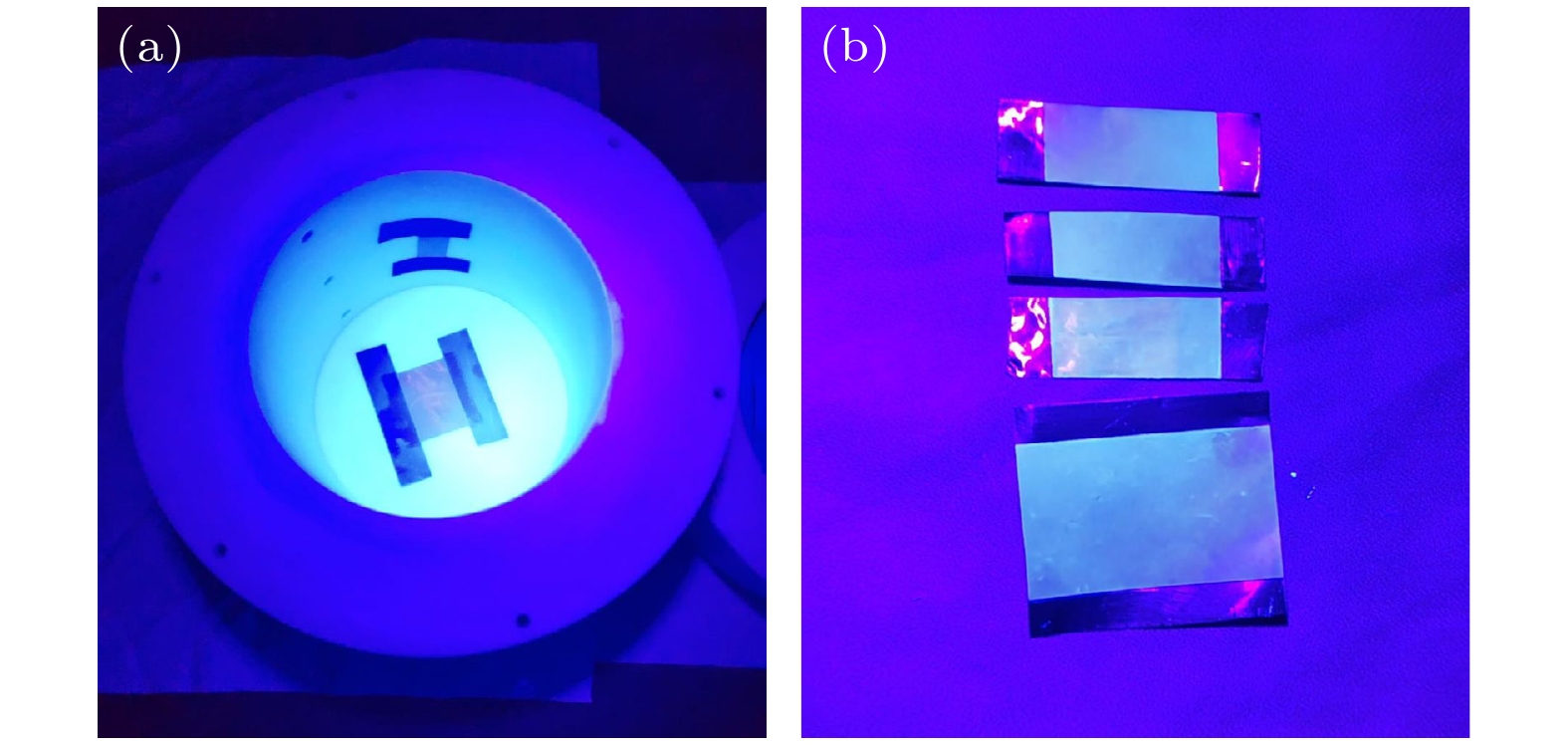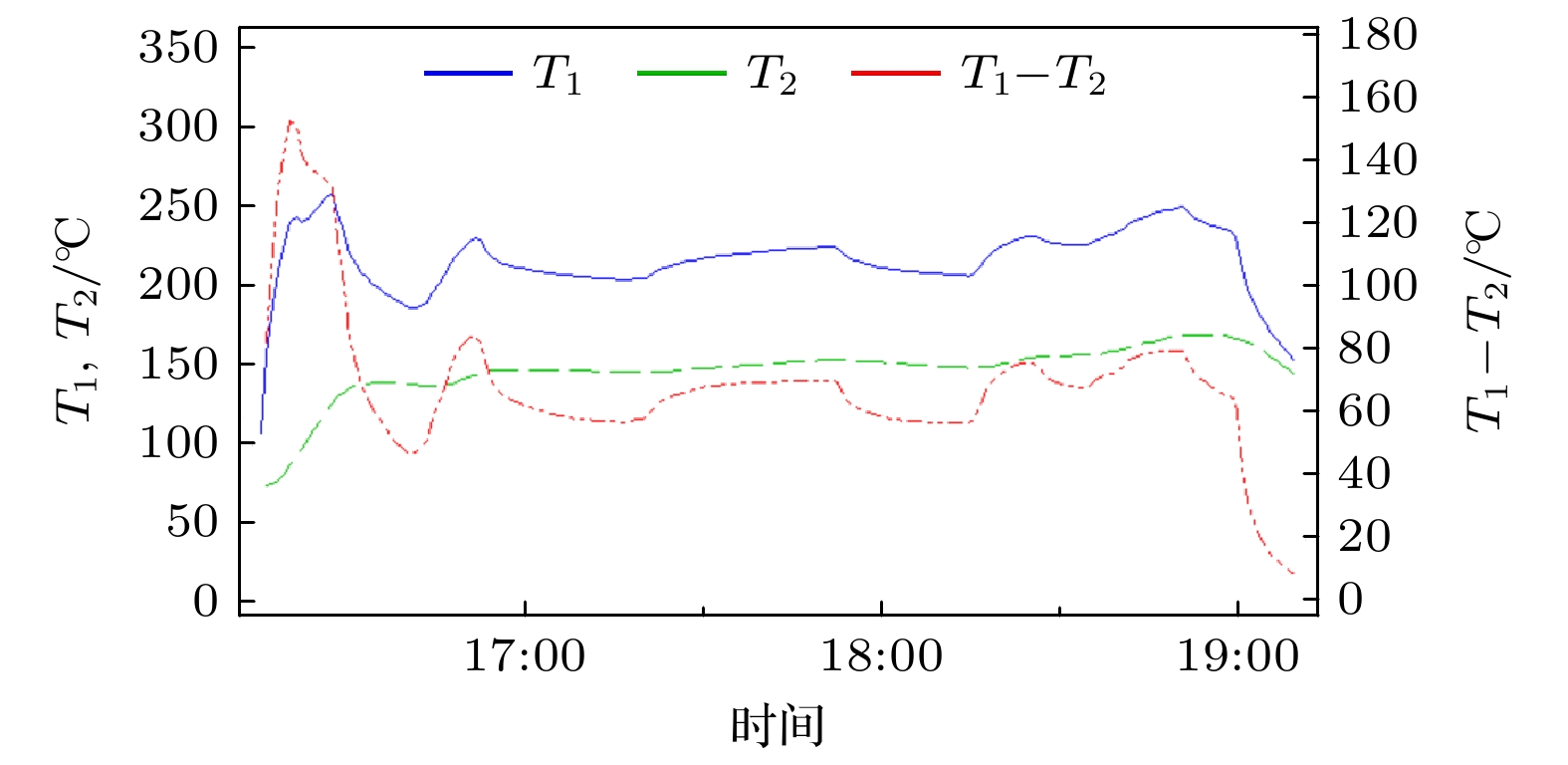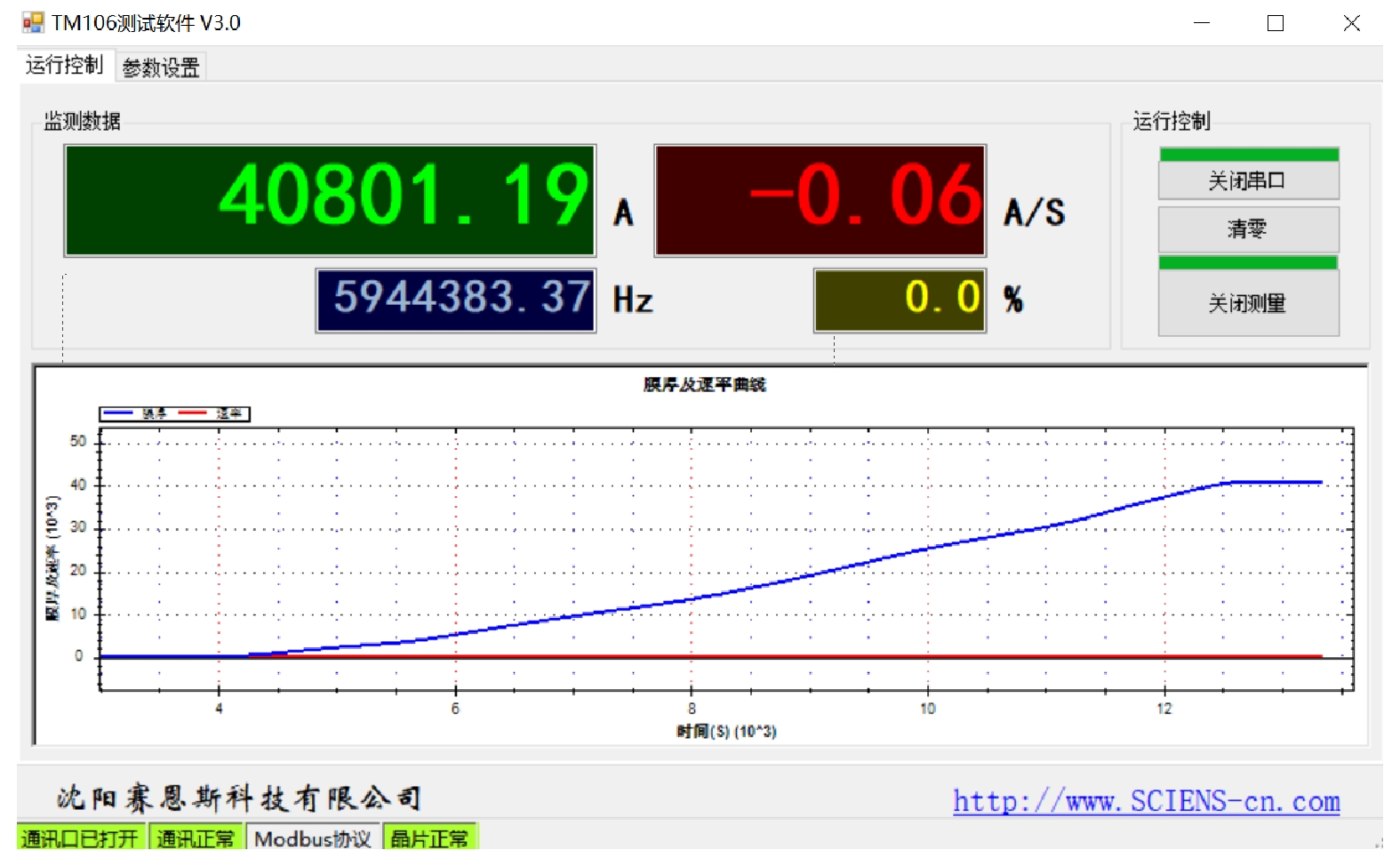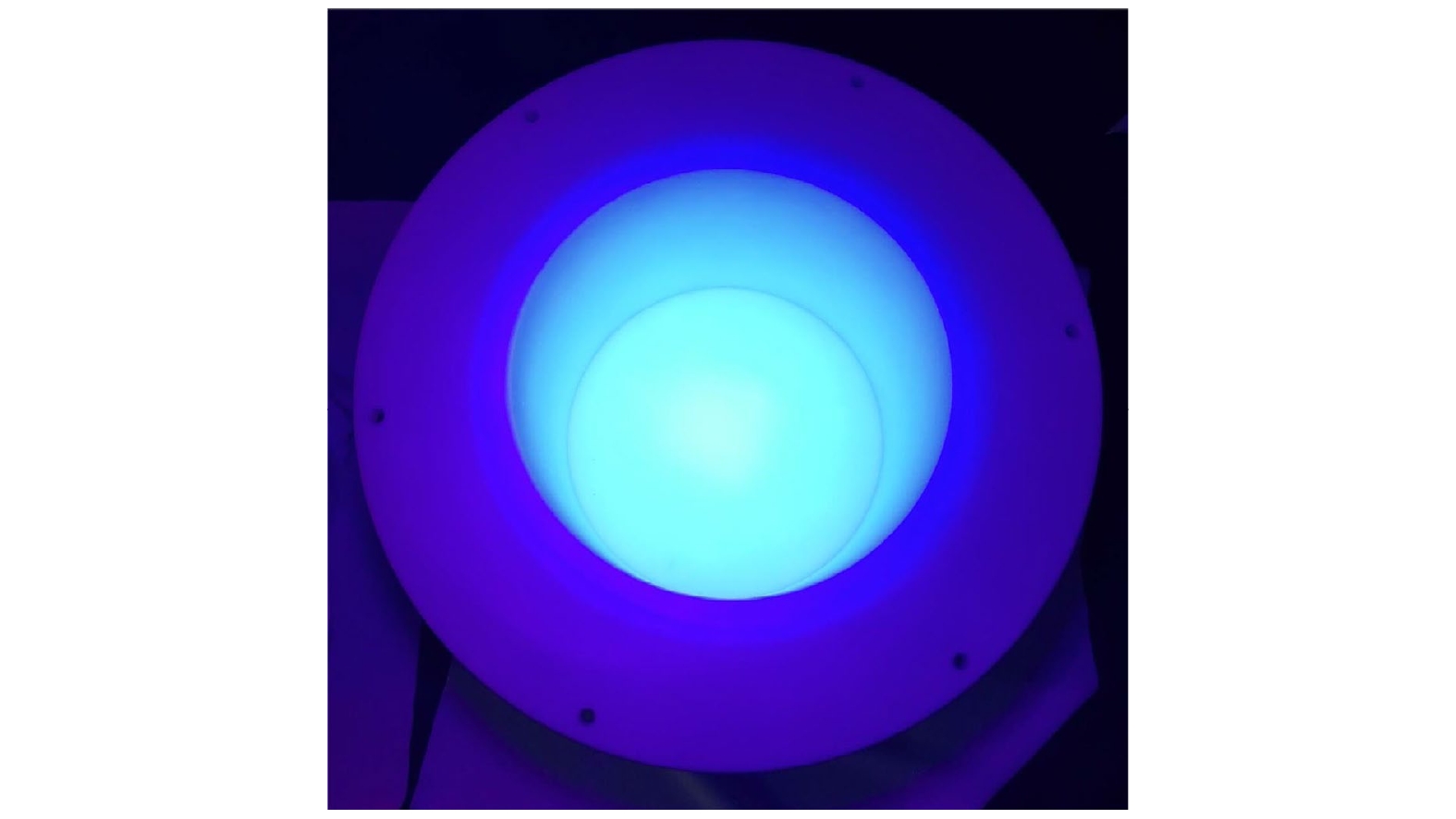-
液氦时间投影室(ALETHEIA)是一个原创的低质量(100 MeV/c2—10 GeV/c2)暗物质探测装置. 入射粒子在液氦时间投影室中与液氦发生相互作用会产生80 nm长的闪烁光. 目前尚无商用光电读出器件可以直接高效读取该闪烁光. 为此, 需要波长迁移剂(wavelength shifter)先将其转换为可见光, 然后再用商用光电读出器件探测之. 在参考国际相关类似涂敷试验装置的基础上, 利用改进的气相沉积法成功地在直径和高度均为10 cm的圆柱形聚四氟乙烯(PTFE)容器内壁涂敷1.50—3.02 μm. 厚的TPB(tetraphenyl butadiene, 1,1,4,4-四苯基-1,3-丁二烯)涂层. 此工艺方法对其他需要在圆柱形探测器内壁涂敷TPB或者其他类似材料的试验具有参考价值. 本文对TPB涂层的涂敷原理、盛放TPB粉末的源的设计、涂敷工艺、涂层厚度监测等方面进行阐述.
ALETHEIA (a liquid hElium time projection cHambEr In dark matter) project is an originally creative dark matter experiment aiming to search for low-mass (100 MeV/c2–10 GeV/c2) WIMPs. While there have existed more than ten experiments doing research on low-mass WIMPs, the ALETHEIA is supposed to grow up to be a leading project worldwide due to many unique advantages, including but are not limited to extremely low intrinsic backgrounds, easy purification , and strong potential capability of signal/background discrimination. Owing to the project’s original creativity, there has existed no direct experience of building such a detector yet; consequently, we have to launch a set of R&D programs from scratch, including the TPB coating process conveyed in this paper. An incident particle that hits a liquid helium detector would generate 80-nm-long scintillation. There are currently no commercially available photon detectors capable of efficiently detecting the scintillation light and a wavelength converter must be used to convert the 80-nm-long scintillator into visible light. Silicon photomultipliers (SiPMs) can then be implemented to detect the 450-nm-wavelength light. The TPB (Tetraphenyl Butadiene, 1, 1,4, 4-tetraphenyl-1, 3-butadiene) is widely used for realizing the conversion. Although in thedark matter experiment using argon pulse-shape discrimination (DEAP) , 2.3-μm-thick TPB is successfully coated on the inner wall of the sphere with a radius of 85 cm, we cannot mimic the whole process in our experiment directly out of the two following reasons: (a) our detector shape is cylindrical, not spherical, and (b) the diameter of the current detector prototype is only 10 cm, while the one of the DEAP detectors is as large as 1.7-meter. Consequently, we must design and build an appropriate coating apparatus suitable for our detector. Owing to the existence of necessary auxiliary parts (such as cables for heating and temperature sensors), on which some vapored TPB molecules would be deposited when the coating is in progress. As a result, a blind spot on the inner wall always exists that cannot be fully coated; the blind spot area will affect the visible light yield of 80-nm-long scintillation. To solve the problem, we split the coating process into two steps: coating the curved surface and one base together in the first step and coating another base in the second step. In this way, the cylindrical detector's whole inner wall (the curved surface and the two bases) will be coated. Another key technology is to design an appropriate source sphere containing TPB powder. There are 20 holes evenly distributed on the surface of the sphere. After the TPB powder is heated andevaporated into the gas, the TPB molecules should move slowly enough to ensure that they scatter from each other long enough within the source before randomly finding a hole to escape. As a result, the TPB molecules come out of the source in an isotropic way then adhere to the inner surfaces of a cylindrical detector (diameter and height are both 10 cm) with nearly the same thickness. The TPB coating thickness on the inner wall is in a range between 1.50 and 3.02 μm, which corresponds to the thinnest and thickest TPB plate, respectively. The variation mainly comes from the different distances from the coating place to the source, which lies at the center of the PTFE cylinder. The thickness difference will not bother us because the conversion efficiency for 80-nm-long scintillation is almost the same as that for the TPB thickness in a range from 0.7 to 3.7 μm. In addition to introducing the ALETHEIA project briefly at the beginning, we mainly address several aspects of TPB coating: coating principle, source design, coating process, coating thickness monitoring, and the comparison of thickness among coating plates from three independent methods. The whole process addressed in this paper is expected to provide a valuable reference for other experiments with similar requirements. -
Keywords:
- ALETHEIA /
- dark matter /
- wavelength shifter /
- TPB /
- evaporation
[1] Zwicky F 1933 Helv. Phys. Acta 6 110
[2] Zwicky F 1937 Astrophys. J. 86 217
 Google Scholar
Google Scholar
[3] Rubin V C, Ford Jr W K 1970 Astrophys. J. 159 379
 Google Scholar
Google Scholar
[4] Salucci P, Nesti F, Gentile G, Martins C F 2010 Astron. Astrophys. 523 A83
 Google Scholar
Google Scholar
[5] Borriello A, Salucci P 2001 Mon. Not. R. Astron. Soc. 323 285
 Google Scholar
Google Scholar
[6] CDEXhttp://cdex.ep.tsinghua.edu.cn/ (accessed 2022-6-26)
[7] PandaXhttps://pandax.sjtu.edu.cn/ (accessed 2022-6-26)
[8] Dampehttp://dampe.ustc.edu.cn/ (accessed 2022-6-26)
[9] Akula S, Feldman D, Liu Z, Nath P, Peim G 2011 Mod. Phys. Lett. A 26 1521
 Google Scholar
Google Scholar
[10] Aalbers J, Akerib D S, Akerlof C W, Al Musalhi A K, Alder F, Alqahtani A, Kraus H 2022 arXiv: 2207.03764
[11] Liao J, Gao Y, Liang Z, Ouyang Z, Peng C, Zhang F, Zhang L, Zheng J, Zhou J 2022 arXiv preprint arXiv: 2203.07901
[12] Liao J, Gao Y, Liang Z, Peng Z, Zhang L, Zhang L 2021 arXiv preprint arXiv: 2103.02161
[13] Biekert A, Chang C, Fink C, Garcia-Sciveres M, Glazer E, Guo W, Hertel S, Kravitz S, Lin J, Lisovenko M 2022 Phys. Rev. D 105 092005
 Google Scholar
Google Scholar
[14] McKinsey D, Brome C, Dzhosyuk S, Golub R, Habicht K, Huffman P, Korobkina E, Lamoreaux S K, Mattoni C, Thompson A K 2003 Phys. Rev. A 67 062716
 Google Scholar
Google Scholar
[15] Ito T, Seidel G 2013 Phys. Rev. C 88 025805
 Google Scholar
Google Scholar
[16] Phan N, Cianciolo V, Clayton S, Currie S, Dipert R, Ito T, MacDonald S, O'Shaughnessy C, Ramsey J, Seidel G 2020 Phys. Rev. C 102 035503
 Google Scholar
Google Scholar
[17] Ito T, Clayton S, Ramsey J, Karcz M, Liu C Y, Long J, Reddy T, Seidel G 2012 Phys. Rev. A 85 042718
 Google Scholar
Google Scholar
[18] Seidel G, Ito T, Ghosh A, Sethumadhavan B 2014 Phys. Rev. C 89 025808
 Google Scholar
Google Scholar
[19] Ito T, Ramsey J, Yao W, Beck D, Cianciolo V, Clayton S, Crawford C, Currie S, Filippone B, Griffith W 2016 Rev. Sci. Instrum. 87 045113
 Google Scholar
Google Scholar
[20] Benson C, Orebi Gann G D, Gehman V 2018 Eur. Phys. J. C 78 1
 Google Scholar
Google Scholar
[21] Howard B, Mufson S, Whittington D, Adams B, Baugh B, Jordan J, Karty J, Macias C, Pla-Dalmau A 2018 Nucl. Instrum. Meth. A 907 9
 Google Scholar
Google Scholar
[22] Pollmann T, Boulay M, Kuźniak M 2011 Nucl. Instrum. Meth. A 635 127
 Google Scholar
Google Scholar
[23] Yang H, Xu Z-F, Tang J, Zhang Y 2020 Nucl. Sci. Tech. 31 1
 Google Scholar
Google Scholar
[24] Bonesini M, Cervi T, Falcone A, Kose U, Mazza R, Menegolli A, Montanari C, Nessi M, Prata M, Rappoldi A 2018 J. Instrum. 13 P12020
 Google Scholar
Google Scholar
[25] Broerman B 2015 M. S. Dissertation (Kingston: Queen's University) (in Canada)
[26] Broerman B, Boulay M G, Cai B, Cranshaw D, Dering K, Florian S, Gagnon R, Giampa P, Gilmour C, Hearns C 2017 J. Instrum. 12 P04017
 Google Scholar
Google Scholar
[27] Pollmann T 2012 Ph. D. Dissertation (Kingston: Queen's University) (in Canada)
[28] http://sciens-cn.com/Demo_1052.html (accessed 2022-06-26)
[29] https://www.fluke.com/en-us/product/temperature-measurement/ir-thermometers/fluke-54-ii (accessed 2022-06-26)
-
图 1 30 g LHe原型机-V1及其零件图 (a) 在中国原子能科学研究院设计和制作的30 g液氦原型机-V1; (b) 真空容器内部; (c) 30 g液氦小室; (d) 将30 g液氦小室拆开后的零件
Fig. 1. The anatomy of the first version of the house-made 30 g LHe detector: (a) The first version of the 30 g LHe detector system designed, assembled, and tested at CIAE; (b) the inner side of the vacuum vessel; (c) the 30 g LHe cell; (d) the parts of the 30 g LHe cell.
表 1 根据涂覆前后的质量差计算的TPB涂覆厚度
Table 1. TPB coating thickness calculation based on the mass difference before and after coating on the aluminum plates.
编号 测试面
积/cm2铝片安装
位置试验前后
增加质量/mg膜厚/μm 1 2 工装内壁 0.75 ± 0.02 3.48 ± 0.11 2 2 工装内壁 0.46 ± 0.04 2.13 ± 0.17 3 2 小室桶壁 0.87 ± 0.04 4.03 ± 0.16 4 6 小室底面 2.54 ± 0.02 3.92 ± 0.03 表 A1 1号铝片的五次称重质量
Table A1. Five times measurement of the mass of 1# aluminum film.
序号 试验前称重/mg 试验后称重/mg 1 92.84 93.53 2 92.83 93.58 3 92.86 93.57 4 92.78 93.63 5 92.80 93.54 -
[1] Zwicky F 1933 Helv. Phys. Acta 6 110
[2] Zwicky F 1937 Astrophys. J. 86 217
 Google Scholar
Google Scholar
[3] Rubin V C, Ford Jr W K 1970 Astrophys. J. 159 379
 Google Scholar
Google Scholar
[4] Salucci P, Nesti F, Gentile G, Martins C F 2010 Astron. Astrophys. 523 A83
 Google Scholar
Google Scholar
[5] Borriello A, Salucci P 2001 Mon. Not. R. Astron. Soc. 323 285
 Google Scholar
Google Scholar
[6] CDEXhttp://cdex.ep.tsinghua.edu.cn/ (accessed 2022-6-26)
[7] PandaXhttps://pandax.sjtu.edu.cn/ (accessed 2022-6-26)
[8] Dampehttp://dampe.ustc.edu.cn/ (accessed 2022-6-26)
[9] Akula S, Feldman D, Liu Z, Nath P, Peim G 2011 Mod. Phys. Lett. A 26 1521
 Google Scholar
Google Scholar
[10] Aalbers J, Akerib D S, Akerlof C W, Al Musalhi A K, Alder F, Alqahtani A, Kraus H 2022 arXiv: 2207.03764
[11] Liao J, Gao Y, Liang Z, Ouyang Z, Peng C, Zhang F, Zhang L, Zheng J, Zhou J 2022 arXiv preprint arXiv: 2203.07901
[12] Liao J, Gao Y, Liang Z, Peng Z, Zhang L, Zhang L 2021 arXiv preprint arXiv: 2103.02161
[13] Biekert A, Chang C, Fink C, Garcia-Sciveres M, Glazer E, Guo W, Hertel S, Kravitz S, Lin J, Lisovenko M 2022 Phys. Rev. D 105 092005
 Google Scholar
Google Scholar
[14] McKinsey D, Brome C, Dzhosyuk S, Golub R, Habicht K, Huffman P, Korobkina E, Lamoreaux S K, Mattoni C, Thompson A K 2003 Phys. Rev. A 67 062716
 Google Scholar
Google Scholar
[15] Ito T, Seidel G 2013 Phys. Rev. C 88 025805
 Google Scholar
Google Scholar
[16] Phan N, Cianciolo V, Clayton S, Currie S, Dipert R, Ito T, MacDonald S, O'Shaughnessy C, Ramsey J, Seidel G 2020 Phys. Rev. C 102 035503
 Google Scholar
Google Scholar
[17] Ito T, Clayton S, Ramsey J, Karcz M, Liu C Y, Long J, Reddy T, Seidel G 2012 Phys. Rev. A 85 042718
 Google Scholar
Google Scholar
[18] Seidel G, Ito T, Ghosh A, Sethumadhavan B 2014 Phys. Rev. C 89 025808
 Google Scholar
Google Scholar
[19] Ito T, Ramsey J, Yao W, Beck D, Cianciolo V, Clayton S, Crawford C, Currie S, Filippone B, Griffith W 2016 Rev. Sci. Instrum. 87 045113
 Google Scholar
Google Scholar
[20] Benson C, Orebi Gann G D, Gehman V 2018 Eur. Phys. J. C 78 1
 Google Scholar
Google Scholar
[21] Howard B, Mufson S, Whittington D, Adams B, Baugh B, Jordan J, Karty J, Macias C, Pla-Dalmau A 2018 Nucl. Instrum. Meth. A 907 9
 Google Scholar
Google Scholar
[22] Pollmann T, Boulay M, Kuźniak M 2011 Nucl. Instrum. Meth. A 635 127
 Google Scholar
Google Scholar
[23] Yang H, Xu Z-F, Tang J, Zhang Y 2020 Nucl. Sci. Tech. 31 1
 Google Scholar
Google Scholar
[24] Bonesini M, Cervi T, Falcone A, Kose U, Mazza R, Menegolli A, Montanari C, Nessi M, Prata M, Rappoldi A 2018 J. Instrum. 13 P12020
 Google Scholar
Google Scholar
[25] Broerman B 2015 M. S. Dissertation (Kingston: Queen's University) (in Canada)
[26] Broerman B, Boulay M G, Cai B, Cranshaw D, Dering K, Florian S, Gagnon R, Giampa P, Gilmour C, Hearns C 2017 J. Instrum. 12 P04017
 Google Scholar
Google Scholar
[27] Pollmann T 2012 Ph. D. Dissertation (Kingston: Queen's University) (in Canada)
[28] http://sciens-cn.com/Demo_1052.html (accessed 2022-06-26)
[29] https://www.fluke.com/en-us/product/temperature-measurement/ir-thermometers/fluke-54-ii (accessed 2022-06-26)
计量
- 文章访问数: 5605
- PDF下载量: 63
- 被引次数: 0














 下载:
下载:
